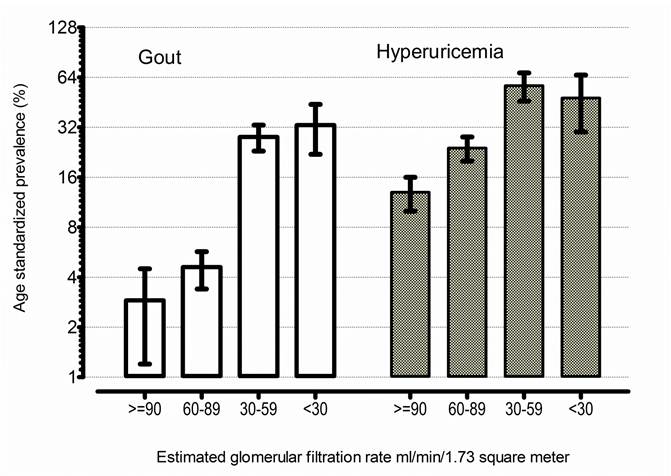Session Information
Session Type: Abstract Submissions (ACR)
Background/Purpose: The kidney is a major route of clearance of uric acid, a product of purine metabolism. The links between kidney disease, hyperuricemia, and gout in the general population are not well understood. Our objective was to estimate prevalence of gout and hyperuricemia among people with chronic kidney disease (CKD) in the US general population.
Methods: The study was designed as a cross-sectional analysis of the most recent National Health and Nutrition Examination Surveys (NHANES 2009-2010), a nationally representative sample of civilian men and women aged 20 years or older (n=5,589). Gout was defined per self-reported physician or health professional diagnosis. . Hyperuricemia was defined as serum urate > 7.0 mg/dL for men and > 6 mg/dL for women. Estimated glomerular filtration rate (eGFR) calculated using the Chronic Kidney Disease-EPI equation was used to classify CKD as mild, moderate or severe.
Results: In 2009-2010, there were 5.2 million men and 2.3 million women with gout in the US. Of these, 1.25 million men and 0.78 million women had moderate or severe CKD. The prevalence of gout and hyperuricemia was 5-fold higher among those with moderate or severe CKD compared to those with no CKD. In multivariable logistic regression analyses that adjusted for age, gender, body mass index, hypertension, diabetes, hypertension medications including diuretics, blood lead levels, and hyperlipidemia the odds ratios of gout and hyperuricemia were 5.8 (1.2, 26.5) and 19.5 (3.8, 99.2) among those with severe CKD compared to those with no CKD.
Conclusion: Gout is a major comorbidity of CKD with about 2 million Americans suffering from gout and moderate to severe CKD. The prevalence for gout and hyperuricemia increases as the severity of CKD worsens.
Disclosure:
E. Krishnan,
savient,
1,
URL, takeda, metbolex,ARDEA,
2,
METABOLEX TAKEDA,
5;
« Back to 2012 ACR/ARHP Annual Meeting
ACR Meeting Abstracts - https://acrabstracts.org/abstract/prevalence-of-gout-among-adults-with-chronic-kidney-disease-in-the-united-states-2009-10/

